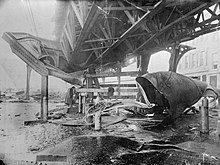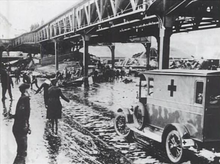Boston molasses disaster
In the Great Molasses Flood on 15 January 1919 with burst molasses -filled tank, after which its contents as up to nine meters high surge over the Boston spilled downtown. 21 people lost their lives.
prehistory

Boston was a distillery center at the beginning of the 20th century , especially rum production . The main basis for the production of rum is molasses, which was stored in large tanks throughout the city. The misfortune tank belonged to the state-owned United States Industrial Alcohol Company and was located in the North End district . It was 27 meters in diameter and 15 meters high, giving a volume of around 8,500 m³ (8.5 million liters).
The tank had structural defects and was not properly maintained. For example, leaks were not repaired. Instead, the employee responsible for monitoring had the tank painted brown (i.e. molasses-colored) so that the leaks would not be noticed.
Course of the disaster
After a molasses delivery from Puerto Rico , the tank was completely filled on January 15, 1919. The air temperature rose rapidly from −14 ° C on the previous day to +5 ° C on the day of the accident. This accelerated the fermentation processes taking place in the tank and increased the pressure on its outer shell.
At around 12:30 p.m., the rivets at the seams of the tank were no longer able to cope with the increasing pressure , and the seams suddenly burst open. Iron parts of the burst tank flew up to 200 meters. At the same time, the full contents of the tank poured into downtown Boston in the form of a syrup wave up to nine meters high at up to 50 km / h. 21 people were killed and 150 injured. Numerous buildings were up to the foundations be destroyed, a large piece of debris brought a certain part of the route of the Atlantic Avenue Elevated to collapse.
Although rescue workers were on site quickly and in large numbers, the rescue work was difficult as people and vehicles could hardly move around in the sticky syrup. The streets and buildings were not completely cleaned until six months later. To do this, several million liters of salt water were pumped out of the harbor basin, as the molasses could hardly be removed with fresh water.
The damage amounted to a total of 600,000 dollars , which - depending on the selected reference ( consumer price index , GDP deflator , wages / salaries for unskilled workers, wages / salaries of employees in production, nominal gross domestic product (GDP) per capita or relative share of GDP) - In 2012, it was worth between $ 6 million and $ 120 million.
Legal processing
The United States Industrial Alcohol Company initially attributed the accident to a bomb attack. In a six-year process, however, it was found that only the structural weaknesses of the tank were the cause of the accident. In total, the company paid about a million dollars to those who suffered the accident. The survivors of the victims received a one-off payment of 7,000 dollars each, which today corresponds to around 70,000 to 1.2 million dollars, depending on the reference figure (see above).
Individual evidence
- ^ Measuring Worth. Archived from the original on February 17, 2015 ; accessed on August 16, 2013 .
Web links
- Corpses under frosting - DER SPIEGEL one day
- Scientific American: The Science of the Great Molasses Flood
- Engineering Disasters - Documentary (ModernMarvels, History) Aerospace Engineering, youtube.com, uploaded August 4, 2017, accessed August 9, 2017. - Video 26: 05–34: 43/43:15 (English)
- Their twitches drew people into the deadly syrup wave
- Cause of death: syrup - a bizarre misfortune changes the USA - geo knowledge
Coordinates: 42 ° 22 ′ 7 ″ N , 71 ° 3 ′ 21 ″ W.


